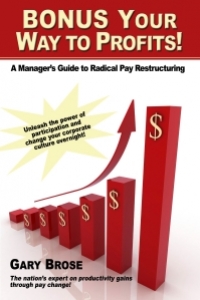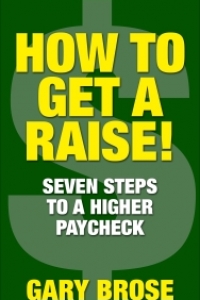ANNOUNCING GARY’S NEW TRAINING 4 PROFIT PACKAGE
Many clients I work with cannot afford a full-blown on-site consultant to guide them through the process of building a more motivated and engaged workforce. I get it. Times are tough and everyone has to cut corners when they can. However, building a better team of employees is a sure way to make lasting change and enhance the value of your company when you are ready to sell!
So, I’ve created a package of 36 short videos, each explaining one of the free and low-cost tactics I’ve developed for my businesses. I created a much more motivated team of workers that propelled my businesses to new heights. You can too. Go here for more information and for less than you would imagine, you can begin today to reshape your business so it runs itself and becomes more valuable in the future. Click the link below for more details!
WILL THERE BE A RECESSION IN 2020?
I was asked that question as a guest on the Politics and Profits Show on ROKU. See my answer below:
Chatting about how to build a motivated and engaged workforce
Had a great time on EANTV’s Politics and Profits TV show on Monday. Talked about employee motivation and engagement. The show can also be seen on the ROKU channel. See it here: https://vimeo.com/345258215
5 Zero-Cost Ways to Re-energize your Workforce
 An energized and engaged workforce can transform your business from an also-ran to a market leader. Building your team up so they enthusiastically greet customers, solve problems through their own initiative, and help to grow sales simply by doing their job exceedingly well is a giant step toward success.
An energized and engaged workforce can transform your business from an also-ran to a market leader. Building your team up so they enthusiastically greet customers, solve problems through their own initiative, and help to grow sales simply by doing their job exceedingly well is a giant step toward success.
Below are five techniques management can use to impact attitudes and begin creating that energized workforce…and they cost you nothing except a bit of your time.
1 – Become a Great Listener – I know, that sounds simplistic, but studies have shown that business leaders who are considered dynamic and at the top of their field always share this same trait. They are all great listeners. So, when you are busy racing toward a deadline and some brave employee ventures into your office and wants to talk, let them. And don’t speak or interrupt. Let them say what they want to say and stay in the moment. Listen to every word. Take notes. Nod. Listen to them as though they were the world’s expert on their topic—as though they were Albert Einstein stopping by to share his thoughts on the Theory of Relativity with you. Then summarize their points at the end and comment on how you will respond (hint: that response should never be dismissive. Even if the idea is terrible, agree to think some more on it and get back to them. And then actually do just that).
2 – Provide High Quality Training – Rethink how you are doing your training. Is it haphazard, off the cuff, an afterthought? Revamp it, build it up and make sure your trainer is the right person. Here’s the deal – your best trainer isn’t necessarily your best employee. And it isn’t your fastest employee either. It is someone who is competent, somewhat methodical, and patient. Nothing leaves a worst first impression on a new-hire than racing through the training at breakneck speed and assuming that the newbie retained all he or she was shown. Have your trainer slow it down, ask repeatedly if they understand before moving on to the next part, and make it an enjoyable experience. Introduce the new employee to everyone and focus on making them feel comfortable. Businesses that provide a first-rate training experience are viewed as more desirable places to work at. Start everyone on the right foot and make sure the training includes 5-10 minutes with a senior management person who discusses “the big picture” and how the employee’s role impacts that.
3 – Catch Someone Doing Something Right – Many business consultants recommend this. I certainly didn’t invent it, but I have used it many times and it is one of the most powerful motivational tools I have ever seen in action. And it is fun too! So, how do you do that? The short version is that you spot someone doing a specific task in near perfect fashion. At that moment, you step in and draw attention to the individual, verbally recapping exactly what the employee did, sharing why it is so important, and confirming with any bystanders that they just witnessed the way to do it. There are so many positive things that come out of that moment: the featured employee gets public praise; the others get a retraining lesson on the right way to do something; all ambiguity about exactly how to perform that task is instantly removed; and you had a very positive exchange with multiple employees. The cost to you? Maybe five minutes.
4 – Maintain a Positive Ratio – Huh? What does that mean? Well, it turns out that multiple independent studies have shown that negative managers (those always nagging or belittling employees) don’t last very long in their jobs, so being more positive is always a good thing. But the question is – HOW positive do they need to be? The answer is to aim for a minimum 5 to 1 positive ratio. That is, try to have five positive moments of employee engagement for every negative one. Here’s the easy part – A positive engagement is when you speak with someone about, well, anything that isn’t negative. You can talk about the weather, sports, weekend plans, employee hobbies, jokes, current events, praise for good performance, factual information about the company, etc. A negative conversation is when you have to discuss poor performance or a mistake or any action that could have been done better. If you have had a reasonable number of positive engagements with an employee, when you have to be critical or negative about some action they took, they will actually listen to you and accept it without rancor. Why? Because you have taken the time to get to know them and you show you actually care. Critical comments then sound more like coaching, not criticizing, because you show you have their best interests at heart.
5 – Be the Servant – This may require a mind-shift for you. Do not think of yourself as the royal leader, the king or queen or the aristocracy. Think of yourself as the facilitator. Your job is to give the employees every tool they need to do their job better. When someone comes to you and says their desk chair can’t be adjusted and it is uncomfortable, don’t think of this being just another untimely intrusion into your precious space or an unwanted budget-breaking item that ruins your monthly P&L. Instead, think about the fact that you have an uncomfortable and unhappy employee who is not at the top of his game and therefore not in a good mood to give his best effort for the customers. Move quickly and take action. When that employee and others see they can trust you to act and can take problems to you, you become their ally and you’ve built trust. When all the employees trust you, you can make impressive changes as needed and in record time.
This, of course, is a very brief summary of five simple techniques. To complete the transformation of your company into a business with fully engaged employees, you still need to do more. I always recommend converting to a pay-for-performance model of compensation and de-linking performance reviews from the raise decision. Those two steps are mandatory if you are going to complete your transformation. The five steps I showed here, lay the groundwork for them. All of these techniques are discussed in my book, Express Exec, and my two previous books, Bonus your Way to Profits and The Ultimate Motivated Employee.
Remember, none of these techniques I’ve discussed here cost you anything other than your time and perhaps a bit of a shift or two in your thinking. It’s been said that we are what we think. I say, you already are, and it may not be working for you as well as you’d like. If so, consider changing your thinking and become a leader people can go to and trust that you’ll do the right thing. In today’s world, dealing with rapid change, the companies that earn the employees’ trust will be the final winners.
DEALING WITH THE PACE OF CHANGE
Are you struggling just to keep up? Join the club.
If you are a business owner or in middle management, one of the toughest problems you face is staying on top of the latest business changes. As time goes by, we are faced with more new ideas, systems, and products coming at us everyday. Just to stay up with it, every executive needs to spend more time reading; more time talking to employees; more time checking out the competition and if you do all that well, you don’t actually have time to do your real job. So, what can you do?
I’ve struggled with this too and over time I came up with the only solution that makes any sense. So, after trying it out in my own business life and seeing some light at the end of the tunnel, I wrote a new business book called EXPRESS EXEC.

This is an unusual business book. I hate to read philosophical jibberish and page after page of examples of those who did it right and wrong. Everyone does that stuff and it gets old. So I wrote EXPRESS EXEC as a novel. That’s right – a short story. I gave my protagonist the unenviable job of having to turn around a company in six months and deal with monstrous amounts of change in a very short period. My story is heavy on dialogue so the reader can hear every painful conversation, every moment of anger from employees, and feel the angst, fear and lack of trust that each employee feels. I added some opposing forces and a few twists and turns because we always run into that in real life. So you get it in the story too – however, I think feeling it, and living it a bit, will help managers to understand better how to deal with it.
Please contact me if you have any stories of your own you want to share, or just want to talk about your own people-management issues.
UPDATE: Express Exec is now available on Amazon – Buy Express Exec Here – and at virtually all other book retailers and outlets in both digital and paperback form.
Follow up to the minimum wage discussion
I caught some flack for my stance on making a dramatic and swift change to the minimum wage. So I did something about it.
 I wrote a book entitled “How to Get a Raise! 7 Steps to a Higher Paycheck”. The solution to the minimum wage issue is not to let government micromanage your life. It is to do it yourself. But I have come to the conclusion that many folks at the minimum wage level simply do now know what to do to escape it. My book simply discusses steps that employees can take (whether they are at minimum wage or not) to get a raise and increase their own pay. The book is now available in eBook form on Amazon at : http://amzn.to/1E46Yow
I wrote a book entitled “How to Get a Raise! 7 Steps to a Higher Paycheck”. The solution to the minimum wage issue is not to let government micromanage your life. It is to do it yourself. But I have come to the conclusion that many folks at the minimum wage level simply do now know what to do to escape it. My book simply discusses steps that employees can take (whether they are at minimum wage or not) to get a raise and increase their own pay. The book is now available in eBook form on Amazon at : http://amzn.to/1E46Yow
Know someone who needs some help, point them in that direction. It is very inexpensive and I will be making it free at various intervals. This isn’t about making money. Just my small contribution to a solution.
No time to read? Watch videos on how to build Bonus Programs!
Most people agree that bonus plans are a good idea. They agree with that until they have to design one. Then it becomes a thankless job and one that very few people can competently complete. For me, it was a necessity. I absolutely needed every employee on the same page as I was. So I spent 25 years in trial and error until I figured out how to do it. As most of you know, I wrote my first book in 2008 describing all the techniques I learned to design and initiate a bonus program that rewarded employees fairly AND returned an equal or greater value to the company.
Well, long story short, no one likes to read anymore. So I summarized all the steps in a series of 14 videos explaining what to do and how to do it. The last of those videos went out this week on YouTube. I also added all of them to my website devoted to my videos on various business topics – mostly how to manage people effectively.
Here is the link to that website and specifically to the page that holds all of the Bonus Plan videos. Don’t want to read? Cool, now you don’t have to. Watch 14 short videos and in less than an hour, you will be able to build bonus programs too. Later, you can thank me for saving you 24 years, 364 days and 23 hours in the process.
Here is the link: http://flyingshorts.com/building-bonus-plans/
Motivation thru Fear
In the business news this week was a story about David Marcus, the President of PayPal. Marcus used a tactic to “motivate the troops” that backfired on him. It is amazing to see someone so high up the ladder make a predictable mistake like this. He used FEAR as a motivator. Usually fear does not work at all. Sometimes it works in the short term but it never lasts. Marcus threatened all his employees’ job security, suggesting they find a new job if they did not cooperate and use PayPal’s new mobile payment app more often. the base of 2,000 workers rebelled and the story went viral.
My evil twin, Garth, who also believes in using fear as a motivator snuck into my studio and made a video about it. Amazing! Clearly Garth and I do not agree. Check out the video here on my other site: www.FlyingShorts.com
http://www.youtube.com/watch?v=vmd1gTqgLqw
IMPROVE PROFIT BY PAYING MORE!
What? You mean by paying less, right? No, I mean paying more. But paying it for different reasons.
One of the most successful steps I’ve ever taken was to spend years perfecting how you can design a bonus program and pay people properly for performance rather than promises. When you carve out a portion of the employee’s pay, say ideally 20% , and earmark that for bonuses (in contrast to paying them everything just for showing up) you can create a full workforce of motivated and engaged employees.
So, how do you do that? Well, my book, Bonus Your Way to Profits! explains that in detail and is available on Amazon today. However, for those who are just interested in the concept, I have started a series of videos on YouTube where I proceed to destroy my own book sales by giving all the information away for free (Hmmmmm, maybe I should rethink this).
Anyway, if you would like to transform your workforce and build a more motivated and engaged group of employees, then build a bonus program for each of them that motivates them to do the right thing for the company out of enlightened self-interest. Pay them part of their salary specifically for achieving goals that help your company improve its bottom line. To explain how to do this, I am in the process of creating over a dozen short 4 minute videos that walk you through it, step by step. To see the first, go here:
http://www.youtube.com/watch?v=7rfjepU2khg
To see the rest, visit my website www.flyingshorts.com and click on the page that takes you to Bonus Programs. All videos relating to that topic are right there in sequence, just waiting for you. OK, no excuses left now. Change your Corporate Culture overnight with pay-for-performance programs that really work!
$15 Minimum Wage: Panacea or False Promise?
Lately, in the Seattle area, there has been a great deal of discussion (and voting) about making a dramatic increase in the minimum wage level. This is mostly due to numerous stories about single moms or people in dire straights who have found themselves in the position of having to attempt to raise a family on one minimum wage job. Much of that has been brought on by the recession and more has occurred because forty and fiftysomething-folks have lost their regular jobs and have had to resort to underemployment. As heartbreaking as these stories are, I don’t believe that the solution is to dramatically increase the minimum wage. A friend of mine asked me my opinion of what would happen if the minimum wage was raised from the current $9.32/hr. to $15/hr. Trying to summarize that quickly was a challenge so I am afraid I resorted to a 900 word answer.
Much of the problem with discussing the minimum wage issue is that those opposed are so afraid of appearing to be greedy corporate profit-mongers that they just find it easier to go along with the $15 minimum wage raise. So at the risk of appearing to put profits before people, I have to ask: Does anyone really believe this is a remedy?
I’ve owned small businesses for 30+ years and let me tell you what will happen if Seattle passes a $15 minimum wage for specific industries or all industries in town: Businesses that are already struggling will just close their doors. Most others will decrease the size of their workforce and turn fulltime employees into part-time. New startups will open in the suburbs but not in Seattle. Nearly everyone will raise prices. Fast food entrees will rise $1 to $2 each. Restaurant prices will go through the roof. Retail products in stores that have a lot of employees on the floor (think big box stores) will raise prices across the board. If the wage increase is limited to fast food or some market segment, everyone else will still be affected. Employees at the normal minimum wage will leave those jobs to try to move into the higher paying minimum wage jobs. So the “unaffected” companies will have to raise pay rates and prices just to compete for workers. If small businesses are exempt, that will only be on paper. In the real world, no one will want to work for $9.50 per hour when they can get $15 at a bigger company so small companies will be forced to raise the starting pay to attract people. And raise their prices too. Many will close and very few new startups will occur.
Worse than all those things, in my opinion, is that many first time workers out of high school will be unable to find jobs. With fewer entry level openings, only experienced people will get the work leaving thousands of young people unemployed in the city. The minimum wage is supposed to be in place to make sure that the young, untrained first time employees get a reasonable pay level as they learn and gain valuable job experience. Frankly, and this sounds harsh, but it is true: Anyone working in the same job for minimum wage for five years or more has made the choice to not advance their own career. Raising a family at the minimum wage level is not possible because it wasn’t meant to be a long-term wage in the first place. It was meant to be a training wage that helps people break in, learn how to work and gain helpful experience so they can move on. Thus this hyper bump-up in pay benefits the long-term minimum wage workers but does nothing but damage to the aspirations of first-time employees. At an artificially inflated rate, only the best workers will keep jobs or get new ones. First time job seekers will be ignored.
If we could legislate our way out of economic inequities, I would be the first one in line supporting it. But artificially raising the minimum wage will not do that. When everyone at the lowest pay level is at $15, they will still be the proverbial “low man on the totem pole”. Fast food will cost more, rents will be higher because the market can support it, restaurant prices will shoot up to a point beyond reach for them, other retail products will cost more and it won’t be long before you hear the cry for a $20 minimum wage … as the new remedy. Relatively, everyone will be the same except that EVERYTHING will cost more – for EVERYONE. And as a sad side effect, those without jobs or with only part-time work, will be far worse off than they are now.
So what can you do if you are stuck in a low end job? What can a minimum wage employee do to change their prospects? First of all, you can quit thinking like a victim. You are not a pawn. You are not powerless. You can go to your boss and ask what you would have to do to earn a raise. He or she will tell you and then raise your game up and earn your raise. Some incredibly short-sighted organizations pay minimum wage only and do not give raises to entry level employees. If you work for one of those, spend your free time interviewing for a job at a company that does reward hard work with raises. Take control of your own fate. Make yourself more valuable to your current employer or your next one. Do NOT sit around waiting for government to rescue you.
Somehow over the years we have lost some of what makes America great. The spirit of individualism; the ability to face adversity and beat it down; the belief that we are the masters of our own fate. I have never seen a hard working employee that did not reap the benefits of that work. Either they earn more from the current employer or they gain the confidence and experience necessary to shape their own career and move on to a better opportunity. Don’t give up on yourself. You are the captain of your own ship. Steer it yourself. You are a free agent. Go after your own dream. Make yourself so valuable that your current employer will gladly pay you more or you will find someone who will. And remind yourself every day: This is America – we make our own chances here.


